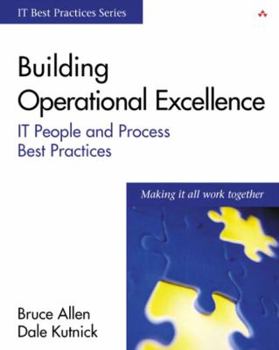Building Operational Excellence: It People and Process Best Practices
A complete guide to achieving operational excellence in enterprise IT organizations. The text provides approaches for assessing current processes (in 2002) and implementing best practices. It covers... This description may be from another edition of this product.
Format:Paperback
Language:English
ISBN:0201767376
ISBN13:9780201767377
Release Date:June 2002
Publisher:Addison-Wesley Professional
Length:240 Pages
Weight:1.30 lbs.
Dimensions:0.7" x 7.4" x 9.2"
Customer Reviews
2 ratings
Excellent Book on Best Practices
Published by Thriftbooks.com User , 15 years ago
When I first picked up this excellent book, I had already spent 11 years doing similar work establishing IT operational systems for large organizations. The practical suggestions and checklists in this book corresponded closely with my experience and I keep the book in front of me on my desk for the past five years and often make a gift of it to others. This book is absolutely unique in the deep knowledge and concise presentation of IT operational support excellence.
Highly refined approach to attaining IT Ops capability
Published by Thriftbooks.com User , 22 years ago
The objectives of this book are to achieve an operational posture that is based on mature processes and an organizational structure that is efficient and delivers value to the business.The authors take a pragmatic approach by making the distinction between best practices from an industry-wide perspective and selective use of best practices to ensure that only those that make sense in the pursuit of your organization are chosen. The three fundamental steps that are addressed by this approach are (1) determine your current operational posture, (2) define quality goals and (3) examine the gaps between where you are and where you want to be. The book is organized to lead you through these three steps in great detail, starting with a definition of best practices (Chapter 1) and laying the foundation by defining tasks and processes and how to move from task- to process-driven methods (Chapter 2). Gap analysis are process refinement are the topics of Chapter 4, which will provide the level of operational maturity to move to the most efficient model proposed in the book called centers of excellence (COE). The collection of COEs are comprised of groupings of core processes that are found in mature IT organizations. By grouping these processes in COEs you can achieve end-to-end service delivery as well as economy of scale. On paper it looks logical, but in practice it is not easy to achieve. In addition if COEs are not carefully structured there can be gaps of responsibility and accountability, which the authors note and provide advice about how to prevent these gaps. Chapter 5 provides a thorough discussion of metrics, while Chapter 6 ties together the concepts in the previous chapters.The most valuable parts of this book are Chapter 7, which is a complete catalog of core processes ranging from application optimization to workload monitoring (31 processes in all) and Chapter 8, which gives eight COE catalogs. The processes in Chapter 7 are depicted with two scales ranging from 1 to 10 for automation and stability, with the following 8 characteristics: (1) tasks, (2) skills, (3) staffing, (4) automation technology, (5) best practices, (6) metrics, (7) process integration and (8) futures. The COE catalogs are slightly different and are structured as follows: (1) attributes, (2) processes, (3) skills, (4) automation, (5) best practices, (6) metrics, and (7) futures.While I think this is a 5-star book that makes an important contribution to IT operational excellence, it isn't without a few flaws. I noticed a few minor problems as the book leads you through a typical process-oriented structure to a COE-based one, such as system administration not being placed in one of the COEs. This is a possible editing error in the book. I also thought that the 1 to 10 scales for automation and stability were defined too ambiguously and the scales are too fine grained given the arbitrary definitions assigned. Many of the illustrations were too busy and misleadi





